How to Make Fajitas
Updated: May 17, 2023
Nothing beats a sizzling platter of ultra juicy, tender beef fajitas. Learn how to perfect your fajita game at home.
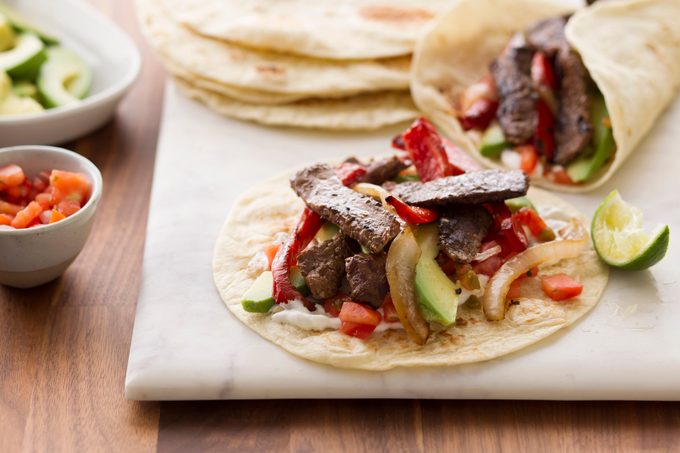
What’s not to love about fajitas? At a restaurant, a gigantic platter of sizzling meat and veggies is served up in a dramatic scene: Heads turn, captivated, as the server marches the dish across the dining room. Its aroma is so enticing, the kitchen crew can predict another dozen orders will quickly follow the first.
According to common lore, Mexican cowboys in West Texas developed fajitas as a way to enjoy inexpensive cuts of meat. They cooked thin slices of meat (“fajitas” loosely translates to “little strips” or “belts”) directly over a campfire.
Our Test Kitchen experts perfected their homemade fajitas using the char of a cast-iron skillet to emulate the smokiness of the fire. This recipe is infinitely adaptable and it comes together in less than 30 minutes. Let’s get cooking!
Master cast iron cooking with our guide.
How to Make Fajitas
You’ll need:
Marinade:
3 tablespoons canola oil
2 tablespoons lemon juice
1 teaspoon dried oregano
1 garlic clove, minced
1/4 teaspoon salt
1/4 teaspoon pepper
Fajitas:
1 pound beef top sirloin steak or flank steak, trimmed
1/2 medium onion, sliced
1 medium sweet pepper, sliced
2 tablespoons canola oil, divided
8 flour tortillas, warmed
2 avocados, peeled and sliced
Salsa
Sour cream
Tools:
Sharp knife
Cast-iron skillet or pan
*A quick note on ingredients: Fajitas are traditionally made with beef and a variety of bell peppers. Choosing colorful veggies will earn you style points, but some people aren’t into the comparatively bitter flavor of green bell peppers. If you’re trying to please picky eaters, stick to red, yellow or orange.
One of the best things about fajitas is how customizable they are. You can use any meat and vegetables you like! For inspiration, and to make this recipe your own, check out the optional variations section below.
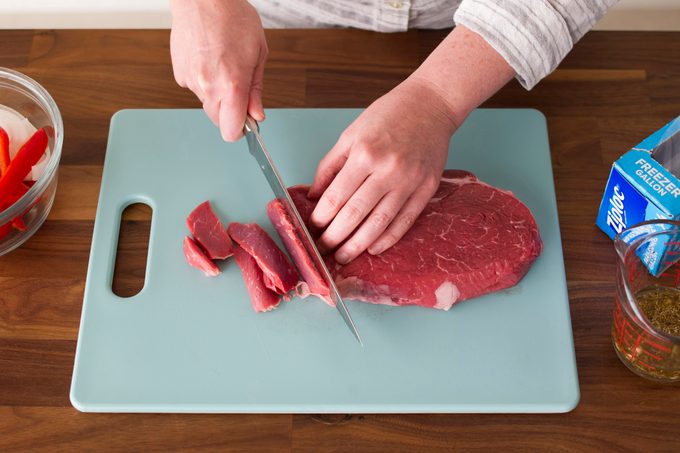
Step 1: Slice the Meat and Veggies
Tough, flavorful cuts of beef (like flank or skirt steak) work exceptionally well for fajitas. Thinly slicing the beef tenderizes it, making it moist and delicious when it’s flash seared. Cut the meat, onion and bell pepper into thin, 1/4-inch strips. Place the onion and pepper in a small bowl and set aside.
Test Kitchen tip: If using beef, make sure you cut against the grain. Look at the direction the fibers run and cut across them (not with them) when making your slices.
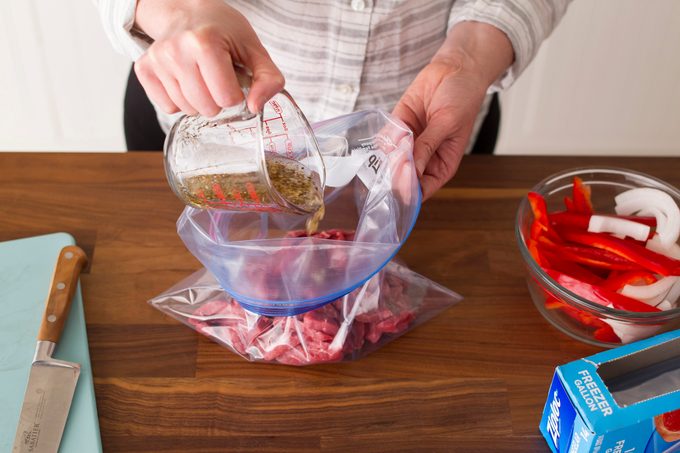
Step 2: Marinate the Meat
Marinating meat is another great way to tenderize tough cuts. The acid (in this case, lemon juice) in the marinade breaks down the proteins in the meat, creating a wonderful texture. Combine the marinade ingredients in a large bowl. Add the beef and toss gently to coat. Cover and refrigerate for at least one hour, or up to overnight.
Test Kitchen tip: Swap in lime juice or vinegar for the lemon juice. All three are acidic ingredients that will tenderize the meat, and each brings its own unique flavor characteristics.
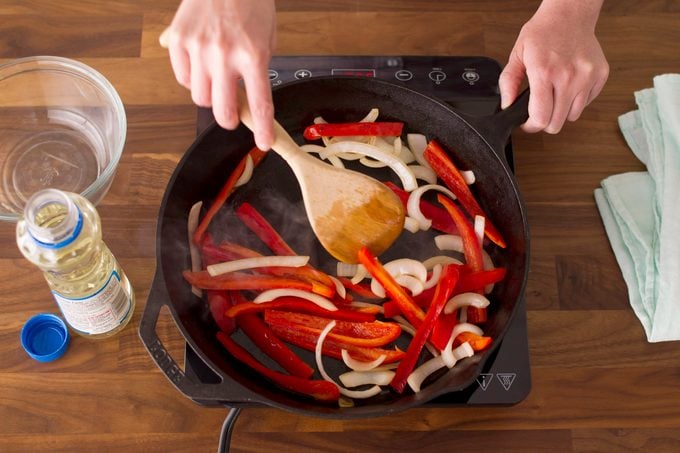
Step 3: Saute the Veggies
Once the meat has finished marinating, this meal comes together in a flash. Heat 1 tablespoon of canola oil over medium-high heat in a cast-iron skillet. Add the onions and peppers and cook until they are crisp-tender. When done, they should be softened and slightly charred. Put the veggies in a small bowl and set aside.
(Wondering how to clean cast iron? Learn step by step how to care for your beloved skillet.)
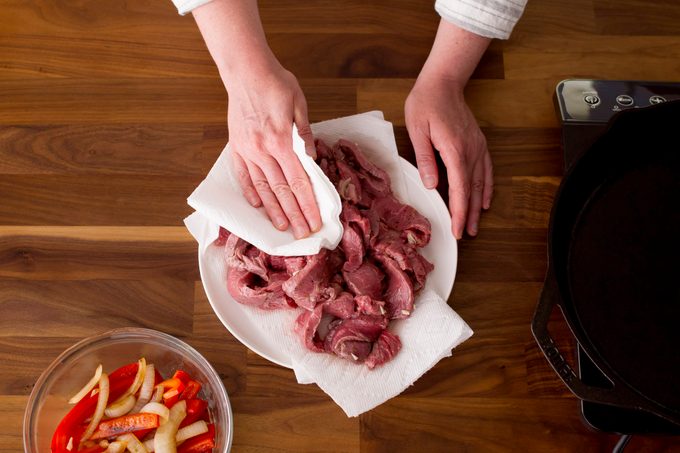
Step 4: Pat the Meat Dry
Patting the meat dry may sound like a simple step that can be skipped, but it’s really important! We want to get a good sear on the meat, but if the beef is saturated in liquid, it is more likely to simmer than sear. Remove the meat from the marinade and discard any excess liquid. Pat the meat dry with paper towels.
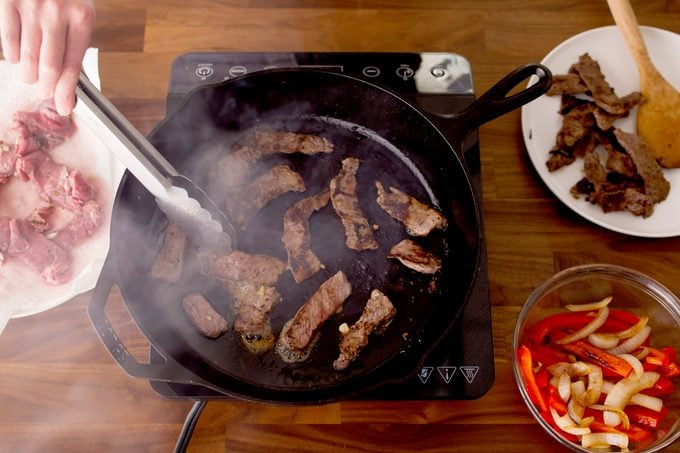
Step 5: Sear the Meat
Now that the meat is dried off, we’re ready to get our sear on. Increase the heat to high and add the remaining 1 tablespoon of oil. When the skillet is just barely smoking, add the meat strips to the pan. Be careful not to overcrowd the pan—the key to delicious fajitas is getting a nice caramelization on the meat. If you add too many strips at once, the beef will steam in its juices instead of sear. If you need to, add the steak in batches.
Cook the meat for 2 minutes per side, until it is nicely browned and no longer pink. Add the vegetables back to the pan and stir until the veggies are heated through. Everything should be nice and sizzling at this point.
Step 6: Warm the Tortillas
Don’t skip this step! Warming the tortillas makes them taste freshly made. Plus, it helps make them more pliable. You’ll thank us when you’re wrapping up all of those delicious fillings.
If you have a gas stove, char the tortillas directly on the flame. This gives them a rustic appearance and adds depth of flavor. Cook them for a few seconds on each side, flipping with tongs. You can also warm them in the microwave (wrapped in a damp paper towel) or in a 300 degree oven (wrapped in aluminum foil).

Step 7: Serve and Enjoy!
Now that everything is ready, let’s bring it all together! Impress your guests by serving these fajitas family-style, re-creating the dramatic restaurant experience by bringing the sizzlin’ cast-iron skillet straight to the table. Or assemble them yourself and serve on plates for convenience.
Either way, create your delicious fajitas by placing a spoonful of the meat-veggie mixture on a warmed tortilla. Top with avocado, salsa and sour cream. Roll the tortilla around the filling and enjoy.
Optional Variations
Fajitas make a perfect weeknight meal because they’re quick and easy and the options are never-ending. Here are some of our favorite substitutions and variations:
- Vegetarian: Go meat-free and bulk up the veggies. Adding mushrooms, beans or cheese will make fajitas nutrient-dense, filling and delicious.
- Seafood: Shrimp fajitas make light and tasty weeknight fare. Shrimp marinate in only 15 minutes and cook up just as quickly.
- Low-Carb: If you’re watching your carbs, substitute hearty greens for the tortillas. Iceberg lettuce or romaine leaves make especially good wraps.
- Spicy: If you’re into the burn, add a sliced jalapeno to the mix. Or, swap out some of the bell pepper for its spicier cousin, poblano.
- Breakfast for Dinner: Add some scrambled eggs and black beans for an anytime breakfast.
- Fresh Additions: Top with colorful extras like thinly sliced radishes, sprigs of cilantro and lime wedges. These fresh and delicious additions are virtually calorie free and will make your fajitas a whole lot snazzier.
Mexican food isn’t all about tacos and fajitas. Add this flan to make your themed dinner complete.

